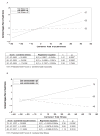Interactive effects of cumulative stress and impulsivity on alcohol consumption
- PMID: 20491738
- PMCID: PMC3676668
- DOI: 10.1111/j.1530-0277.2010.01221.x
Interactive effects of cumulative stress and impulsivity on alcohol consumption
Abstract
Background: Alcohol addiction may reflect adaptations to stress, reward, and regulatory brain systems. While extensive research has identified both stress and impulsivity as independent risk factors for drinking, few studies have assessed the interactive relationship between stress and impulsivity in terms of hazardous drinking within a community sample of regular drinkers.
Methods: One hundred and thirty regular drinkers (56M/74F) from the local community were assessed for hazardous and harmful patterns of alcohol consumption using the Alcohol Use Disorders Identification Test (AUDIT). All participants were also administered the Barratt Impulsiveness Scale (BIS-11) as a measure of trait impulsivity and the Cumulative Stress/Adversity Checklist (CSC) as a comprehensive measure of cumulative adverse life events. Standard multiple regression models were used to ascertain the independent and interactive nature of both overall stress and impulsivity as well as specific types of stress and impulsivity on hazardous and harmful drinking.
Results: Recent life stress, cumulative traumatic stress, overall impulsivity, and nonplanning-related impulsivity as well as cognitive and motor-related impulsivity were all independently predictive of AUDIT scores. However, the interaction between cumulative stress and total impulsivity scores accounted for a significant amount of the variance, indicating that a high to moderate number of adverse events and a high trait impulsivity rating interacted to affect greater AUDIT scores. The subscale of cumulative life trauma accounted for the most variance in AUDIT scores among the stress and impulsivity subscales.
Conclusions: Findings highlight the interactive relationship between stress and impulsivity with regard to hazardous drinking. The specific importance of cumulative traumatic stress as a marker for problem drinking is also discussed.
Figures


Similar articles
-
Self-reported impulsivity, but not behavioral choice or response impulsivity, partially mediates the effect of stress on drinking behavior.Stress. 2013 Jan;16(1):3-15. doi: 10.3109/10253890.2012.671397. Epub 2012 Apr 4. Stress. 2013. PMID: 22376044 Free PMC article.
-
Hazardous drinking and dimensions of impulsivity, behavioral approach, and inhibition in adult men and women.Alcohol Clin Exp Res. 2012 Jun;36(6):958-66. doi: 10.1111/j.1530-0277.2011.01708.x. Epub 2012 Apr 5. Alcohol Clin Exp Res. 2012. PMID: 22486201 Free PMC article.
-
Can't stop the craving: the effect of impulsivity on cue-elicited craving for alcohol in heavy and light social drinkers.Psychopharmacology (Berl). 2012 Jan;219(2):511-8. doi: 10.1007/s00213-011-2240-5. Epub 2011 Mar 8. Psychopharmacology (Berl). 2012. PMID: 21384105 Free PMC article.
-
Components of behavioural impulsivity and automatic cue approach predict unique variance in hazardous drinking.Psychopharmacology (Berl). 2012 Jan;219(2):501-10. doi: 10.1007/s00213-011-2396-z. Epub 2011 Jul 7. Psychopharmacology (Berl). 2012. PMID: 21735071
-
Behavioral and biological indicators of impulsivity in the development of alcohol use, problems, and disorders.Alcohol Clin Exp Res. 2010 Aug;34(8):1334-45. doi: 10.1111/j.1530-0277.2010.01217.x. Epub 2010 May 14. Alcohol Clin Exp Res. 2010. PMID: 20491733 Free PMC article. Review.
Cited by
-
Self-reported impulsivity, but not behavioral choice or response impulsivity, partially mediates the effect of stress on drinking behavior.Stress. 2013 Jan;16(1):3-15. doi: 10.3109/10253890.2012.671397. Epub 2012 Apr 4. Stress. 2013. PMID: 22376044 Free PMC article.
-
Integrated intervention program for alcoholism improves impulsiveness and disadvantageous reward processing/risk-taking.Indian J Psychiatry. 2020 Jul-Aug;62(4):384-391. doi: 10.4103/psychiatry.IndianJPsychiatry_103_20. Epub 2020 Jul 27. Indian J Psychiatry. 2020. PMID: 33165375 Free PMC article.
-
Individual differences in the associations between risk factors for alcohol use disorder and alcohol use-related outcomes.Psychol Addict Behav. 2021 Aug;35(5):501-513. doi: 10.1037/adb0000733. Epub 2021 Jun 10. Psychol Addict Behav. 2021. PMID: 34110841 Free PMC article.
-
Impulsivity interacts with momentary PTSD symptom worsening to predict alcohol use in male veterans.Am J Drug Alcohol Abuse. 2018;44(5):524-531. doi: 10.1080/00952990.2018.1454935. Epub 2018 Apr 11. Am J Drug Alcohol Abuse. 2018. PMID: 29641264 Free PMC article.
-
Dysregulated responses to stress and alcohol cues in cortico-striatal-limbic regions in social drinkers with early trauma.J Neural Transm (Vienna). 2025 Jun 11. doi: 10.1007/s00702-025-02961-9. Online ahead of print. J Neural Transm (Vienna). 2025. PMID: 40500419
References
-
- Allen JP, Litten RZ, Fertig JB, Babor T. A review of research on the Alcohol Use Disorders Identification Test (AUDIT) Alcohol Clin Exp Res. 1997;21:613–619. Review. - PubMed
-
- Asahi S, Okamoto Y, Okada G, Yamawaki S, Yokota N. Negative correlation between right prefrontal activity during response inhibition and impulsiveness: a fMRI study. Eur Arch Psychiatry Clin Neurosci. 2004;254:245– 251. - PubMed
-
- Babor TF, Higgins-Biddle JC, Saunders JB, Monteiro MG. Guidelines for use in primary care. 2. World Health Organization. Department of Mental Heath and Substance Dependence; 2001. AUDIT. The Alcohol Use Disorders Identification Test.
-
- Barr CS, Newman TK, Lindell S, Shannon C, Champoux M, Lesch KP, Suomi SJ, Goldman D, Higley JD. Interaction between serotonin transporter gene variation and rearing condition in alcohol preference and consumption in female primates. Arch Gen Psychiatry. 2004;61:1146–1152. - PubMed
-
- Bohn MJ, Babor TF, Kranzler HR. The Alcohol Use Disorders Identification Test (AUDIT): validation of a screening instrument for use in medical settings. J Stud Alcohol. 1995;56:423–432. - PubMed
Publication types
MeSH terms
Grants and funding
LinkOut - more resources
Full Text Sources
Medical
Miscellaneous

